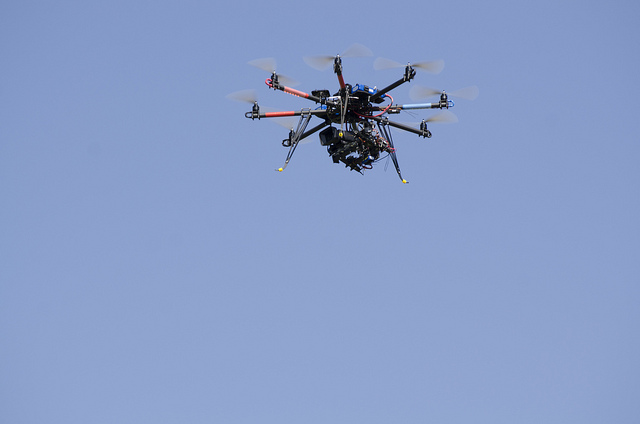Drones clearly carry huge advantages, but they also raise tricky questions. What happens when they see things that should stay private?
State Farm, AIG and USAA have received preliminary approval from the Federal Aviation Administration to test drones for their claims and underwriting functions. On the surface, this sounds like a straightforward proposition. Drones can more quickly and easily survey damage sites after fires, tornados and hurricanes than personnel on the ground. Drones can be equipped to use global positioning software to identify insured structures and take pictures of damage to better and more quickly inform ground-based adjusters, leading to faster settlements and good press for insurers. Drones might also be used by adjusters to reveal hail damage on roofs, which will help to mitigate falls and other injuries to adjusters. The thought is that drones also might be helpful in certain loss control activities, such as identifying otherwise hidden internal or external fire hazards to large structures or plants.
Small portable drones may also find bodies or even survivors in the aftermath of storms. Drones and their operators may see crimes such as looting or arson being committed.
But questions arise: What responsibilities will insurers now have to report crimes to the authorities? How quickly will insurers be required to report? Some drones may use live streamed images to ground-based operators; others may take static pictures that will be retrieved when the drone returns to base. Will the drone-equipped disaster adjuster be required to analyze these pictures immediately or send them to the authorities via Internet uplink as soon as they are retrieved? To avoid problems, should drones not be sent in until after all rescue efforts have ended? However, would this also not create an ethical issue about delaying the use of lifesaving tools because of possible legal complications?
What issues of privacy of customer information or stranger images will insurers face as a result of these new capabilities? For example, the camera is left on while the drone ascends the side of the building, capturing images of people in various stages of dress, seeing a man beating a woman on the 14th or witnessing people shooting up at a party in the penthouse. What must the adjuster report and to whom? What if the party in the penthouse is for diabetics and the adjuster reports this to police as a suspicious incident? Will the adjuster now need to add police investigative skills to competency requirements? How secure will these drones be from tampering if they should malfunction, or how easily can hackers intercept image transmission? Will they be equipped to hear, meaning they can record conversations that may have otherwise been thought to be confidential? In other words, will the drone engender additional responsibilities for the adjuster or will issues otherwise be covered by existing laws and regulations?
We can argue that the courts have agreed that our expectations of privacy with airplanes flying overhead is already reduced. However, airplanes and other commercial or pleasure craft rarely fly under 1,000 feet for any length of time. Commercial drones will operate at a much more personal, in-your-face, level; today they cannot fly higher than 400 feet. Will the courts react the same way as they have with aircraft to privacy concerns associated with drones?
Underwriters will want to use drones, as well, to survey large property complexes to establish baselines not only for pricing and capacity purposes but to provide claims adjusters with a before-loss picture of the property. Drones may also capture more than their own customer’s property. For example, the drone captures a picture or a video of a new product being tested in a courtyard of another business. The other business, fearing industrial espionage, calls the police and gives the clearly visible drone FAA-issued ID number to them.
Ground-based adjusters can trespass or go where they aren’t wanted. However, most are trained to get permission directly from owners and others before trampling on private property. I do not think we will see distantly operated drones knocking on doors, “Greetings human, I am seeking permission to scan your property…please sign here or just nod your agreement.”
Then again, there is the psychological. The convoy of multiple insurer trucks shows up at the town just after a devastating tornado. Up go the drones, circling like buzzards over the wreckage and the dead. Townspeople make rude gestures to the eyes in the sky and clamor after the trucks to gain anything, any image of a missing relative or friend. And the police and fire officials are there, too, crowding the adjusters for information. Will the insurers need to circle the wagons, be available all together to the authorities in an approved command post so that the authorities can gain immediate access to their images? The authorities might have some immunity if they arrest looters from these pictures, but will the insurers, for giving the authorities pictures of the alleged crime? Will the drone bring more frivolous lawsuits from perpetrators of crimes at disaster sites for invasions of personal privacy?
I do not want this to be a Luddite’s rant against drones. Far from it; drones have useful purposes. While drone capabilities were honed in war, their peaceful use should be considered. There is no reason why realtors, insurers, surveyors and others should not have a shot at making their case to use drones in the course of their legitimate business. However, there will be others who use drones in less than legal ways, and we must provide some guidance to insurers and others what constitutes legal and authorized use. We must also have means within each drone’s system that provide credible and legal evidentiary documentation of use: authorized, legal or not. Because the drone increases the field of vision for its user, issues of privacy and legitimate acquisition of images and other information by authorities needs to be spelled out. Disposal of drones must also be spelled out in regulations so that they or any remnant information are destroyed so that they do not get into the wrong hands.
The question isn’t whether drones will be used for legitimate business reasons; the question is when. Because they increase the visibility of their users, issues are raised in the area of privacy that require discussion and perhaps court attention. There is also the unknown, the psychological—the vulture drones over the tornado-stricken town. People in war zones have learned to fear the drones because they are harbingers of death. Granted, we have not experienced drone warfare in the U.S., but we know that they have been used as impersonal killers in other places. Unlike whirring helicopters and buzzing planes, they are small, quiet, can hover low to the ground and will interface with individuals. What will we think of the drone climbing outside of our apartment building with its dark camera lens pointed directly at us? Will we think Big Brother, or will we come to accept this new technology as we have the convenience store video camera or the red-light camera at the busy intersection?
These questions must be asked and answered to some satisfaction before we go trundling off and build vast drone fleets. The time is now, because after drones are deployed is not the time to understand that the user has increased his or her company’s risk of lawsuit and even criminal prosecution that has not been properly identified, assessed, and managed.
Select articles and studies of the issues associated with drones.
-- Calo, Ryan. "The Drone as Privacy Catalyst." Stanford Law Review Online 64 (2011): 29-33. Abstract: Associated today with the theater of war, the widespread domestic use of drones for surveillance seems inevitable. Existing privacy law will not stand in its way. It may be tempting to conclude on this basis that drones will further erode our individual and collective privacy. Yet the opposite may happen. Drones may help restore our mental model of a privacy violation. They could be just the visceral jolt society needs to drag privacy law into the 21st century.
-- Cavoukian, Ann. Privacy and Drones: Unmanned Aerial Vehicles. Information and Privacy Commissioner of Ontario, Canada, 2012. Summary: The aim of this paper is to provide a background for general privacy readers, as well as for potential users or regulators of UAV activities, as they relate to the collection, use, and disclosure of personal information.
-- Friedenzohn, Daniel, and Alexander Mirot. "The Fear of Drones: Privacy and Unmanned Aircraft." Journal of Law Enforcement 3, No. 5 (2013): 1-14. Abstract: The article focuses on the consequence of the use of unmanned aircraft systems, (UAS) or drones, planned to be integrated by U.S. in the national space. Topics discussed use of the technology by military forces, confirmation hearings of disclosed by Central Intelligence Agency (CIA) Director John Brennan and degradation of privacy as a result of law enforcement's relation with the use of the UAS.
-- Pasztor, Andy, and John Emshwiller. "Drone Use Takes Off on the Home Front." The Wall Street Journal, April 12, 2012. Issue Discussed: With little public attention, dozens of universities and law-enforcement agencies have been given approval by federal aviation regulators to use unmanned aircraft known as drones, according to documents obtained via Freedom of Information Act requests by an advocacy group.
-- Wesson, Kyle, and Todd Humphreys. "Hacking Drones." Scientific American 309, No. 5 (2013): 55-59. Abstract: The article focuses on the lack of safety measures in drone aircraft. It states that drones can be used in various settings, which include search and rescue operations, scientific research and power line monitoring. Also mentioned are the Modernization and Reform Act of 2012 issued by the U.S. Federal Aviation Administration (FAA), effectiveness of jamming devices in the navigation system of drones and the challenges to balance the economic benefits of drones. considering the public safety.


